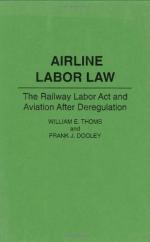|
This section contains 3,426 words (approx. 12 pages at 300 words per page) |

|
United States 1926
Synopsis
The Railway Labor Act (RLA) of 1926 was the most important piece of labor legislation "and the most significant attempt by the federal government to foster and regulate collective bargaining" prior to the New Deal. The RLA was the result of many years of effort to find a labor relations policy for U.S. railroads that would minimize labor unrest and avoid potentially crippling blockages of the nation's main arteries of transportation and commerce. The law provided for the creation of a mediation apparatus and empowered the president of the United States to seek a cooling-off period for parties to a railroad labor dispute. The act encouraged collective bargaining and forbade employers from interfering in workers' selection of their representatives. Subsequent judicial interpretations prevented employers from forcing workers to bargain through company-dominated unions, an important legal breakthrough that pres-aged elements of New...
|
This section contains 3,426 words (approx. 12 pages at 300 words per page) |

|


